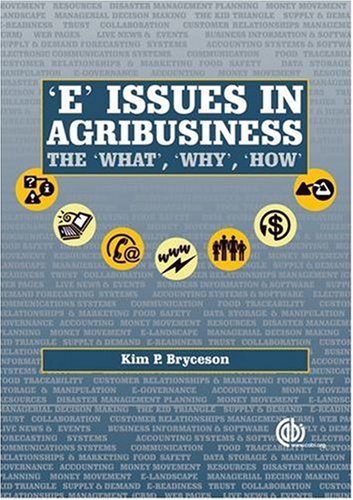

Most ebook files are in PDF format, so you can easily read them using various software such as Foxit Reader or directly on the Google Chrome browser.
Some ebook files are released by publishers in other formats such as .awz, .mobi, .epub, .fb2, etc. You may need to install specific software to read these formats on mobile/PC, such as Calibre.
Please read the tutorial at this link. https://ebooknice.com/page/post?id=faq
We offer FREE conversion to the popular formats you request; however, this may take some time. Therefore, right after payment, please email us, and we will try to provide the service as quickly as possible.
For some exceptional file formats or broken links (if any), please refrain from opening any disputes. Instead, email us first, and we will try to assist within a maximum of 6 hours.
EbookNice Team

Status:
Available0.0
0 reviews
ISBN 10: 1845930711
ISBN 13: 9781845930714
Author: KP Bryceson
This book looks into the "what" is electronically-enabled agribusiness? "Why"would an agribusiness want to embrace it? And "how" does one go about doing it? The book pulls together a number of major issues facing people moving into the electronically enabled agribusiness environment.
This book is both an introduction to electronic business issues and a comprehensive guide to more detailed business processes and strategic planning matters associated with the technologies involved. In particular the following key areas are addressed, concepts, technology in business, e-enabled business models and e-strategies, management concepts and innovative education.
Chapter 1: Chemistry: The Study of Change
Chapter 2: Atoms, Molecules & Ions
Chapter 3: Mass Relationships in Chemical Reactions
Chapter 4: Reactions in Aqueous Solutions
Chapter 5: Gases
Chapter 6: Thermochemistry
Chapter 7: Quantum Theory and the Electronic Structure of Atoms
Chapter 8: Relationships Among the Elements
Chapter 9: Chemical Bonding I: Basic Concepts
Chapter 10: Chemical Bonding II: Molecular Geometry and Hybridization of Atomic Orbitals
Chapter 11: Intermolecular Forces, Liquids & Solids
Chapter 12: Physical Properties of Solutions
Chapter 13: Chemical Kinetics
Chapter 14: Chemical Equilibrium
Chapter 15: Acids & Bases
Chapter 16: Acid-Base and Solubility Equilibria
Chapter 17: Chemistry in the Atmosphere
Chapter 18: Entropy, Free Energy & Equilibrium
Chapter 19: Electrochemistry
Chapter 20: Metallurgy and the Chemistry of Metals
Chapter 21: Non-Metallic Elements and their Compounds
Chapter 22: Transition Metal Chemistry & Coordination Compounds
Chapter 23: Nuclear Chemistry
Chapter 24: Organic Chemistry
Chapter 25: Synthetic and Natural Polymers
why is agribusiness important
agribusiness issues
problems in agribusiness
why is agribusiness bad
why is agribusiness good
Tags: KP Bryceson, E Issues, Agribusiness